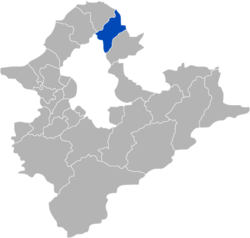Jinshan District, New Taipei
|
Jinshan 金山區 |
|
|---|---|
| District | |
| Jinshan District | |
 |
|
 Jinshan District in New Taipei City |
|
| Coordinates: 25°14′10″N 121°37′03″E / 25.23611°N 121.61750°ECoordinates: 25°14′10″N 121°37′03″E / 25.23611°N 121.61750°E | |
| Country | Taiwan |
| Region | Northern Taiwan |
| Special municipality | New Taipei City (新北市) |
| Area | |
| • Total | 49.21 km2 (19.00 sq mi) |
| Population (January 2016) | |
| • Total | 22,273 |
| Time zone | CST (UTC+8) |
| Postal code | 208 |
| Website | http://www.jinshan.ntpc.gov.tw |
| Jinshan District | |||||||||||||||||||
| Chinese | 金山區 | ||||||||||||||||||
|---|---|---|---|---|---|---|---|---|---|---|---|---|---|---|---|---|---|---|---|
| Literal meaning | Golden Mountain | ||||||||||||||||||
|
|||||||||||||||||||
| Transcriptions | |
|---|---|
| Standard Mandarin | |
| Hanyu Pinyin | Jīnshān Qū |
| Bopomofo | ㄐㄧㄣ ㄕㄢ ㄑㄩ |
| Tongyong Pinyin | Jinshan Cyu |
| Hakka | |
| Romanization | Kîm-sân Khî |
| Southern Min | |
| Hokkien POJ | Kim-san Khu |
Jinshan District (Chinese: 金山區) is a rural district on the coast in northern New Taipei, Taiwan. The district draws many visitors each year because of its hot springs and its proximity to Chin Pao San and the Ju Ming Museum. The district is home to the Dharma Drum Buddhist College, an institution of higher learning founded by Dharma Drum Mountain monastics devoted to the principles of Zen Buddhism.
This area was originally a Ketagalan settlement, called "Ki-ppare" (Basay: Quimourije), meaning "bumper harvest". This was later adapted as Kimpauli (金包里; Pe̍h-ōe-jī: Kim-pau-lí), the choice of characters perhaps influenced by the discovery of golden dust in the Sulfur creeks. In 1920 during Japanese rule, the area was renamed Kanayama Village (金山庄), Kīrun District (基隆郡), Taihoku Prefecture.
Longyuan, Micang, Dakan, Beitou, Dinggu, Jiucheng, Xuntang, Peiqian, Zhangkeng and Xiagu Village.
...
Wikipedia
